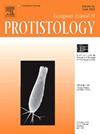来自中国的新土壤纤毛虫 Holostichides (Holostichides) parachardezi nov.(来自中国的一种新的土壤纤毛虫。
IF 1.6
2区 生物学
Q4 MICROBIOLOGY
引用次数: 0
摘要
采用形态学和分子方法研究了一种采集自中国热带城市的新尿囊纤毛虫--Holostichides (Holostichides) parachardezi。该新种的诊断特征包括:体内大小为 140-180 × 30-60 μm;25-43 个大核结节;无色皮质颗粒;3-6 个前端盘片;由 7-11 对盘片组成的中腹复合体和由 5-11 个盘片组成的一排中腹盘片;分为 4 组的 4 个双极性背侧基片和 6-9 个尾部盘片;以及陆生栖息地。它的本体发生遵循典型的 Holostichides 模式,即:(1) 亲体口膜区的近端部分被部分更新,opisthe 的口腔原基起源于非常靠近中腹复合体的位置;(2) 最后一个第 n 节产生前端的圈排,中腹复合体从第 IV 节到第 n - 1 节形成;(3) 边缘排和背侧动节原基都在亲体排内发育。目前的 SSU rDNA 系统发生证实了 Holostichides 属的单系性。本文章由计算机程序翻译,如有差异,请以英文原文为准。
Morphology, morphogenesis, and molecular phylogeny of Holostichides (Holostichides) parachardezi nov. spec. (Ciliophora, Hypotrichia, Urostylida), a new soil ciliate from China
A new urostylid ciliate, Holostichides (Holostichides) parachardezi, collected from a Chinese tropical city, was studied using morphological and molecular methods. Diagnostic features of the new species include: size 140–180 × 30–60 μm in vivo; 25–43 macronuclear nodules; colourless cortical granules; three to six frontoterminal cirri; a midventral complex composed of seven to eleven cirral pairs and one midventral row of five to eleven cirri; four bipolar dorsal kineties and six to nine caudal cirri in four groups; and a terrestrial habitat. Its ontogenesis follows the typical Holostichides mode in that (1) the proximal portion of the parental adoral zone of membranelles is partly renewed and the opisthe’s oral primordium originates very close to the midventral complex; (2) the last anlage n generates the frontoterminal cirral row, and the midventral complex is formed from anlage IV to n − 1; and (3) both marginal rows and dorsal kinety anlagen develop within the parental rows. The present SSU rDNA phylogenies corroborated the monophyly of the genus Holostichides.
求助全文
通过发布文献求助,成功后即可免费获取论文全文。
去求助
来源期刊

European journal of protistology
生物-微生物学
CiteScore
4.60
自引率
20.70%
发文量
55
审稿时长
14.6 weeks
期刊介绍:
Articles deal with protists, unicellular organisms encountered free-living in various habitats or as parasites or used in basic research or applications. The European Journal of Protistology covers topics such as the structure and systematics of protists, their development, ecology, molecular biology and physiology. Beside publishing original articles the journal offers a forum for announcing scientific meetings. Reviews of recently published books are included as well. With its diversity of topics, the European Journal of Protistology is an essential source of information for every active protistologist and for biologists of various fields.
 求助内容:
求助内容: 应助结果提醒方式:
应助结果提醒方式:


